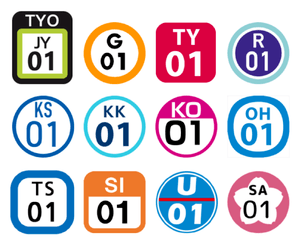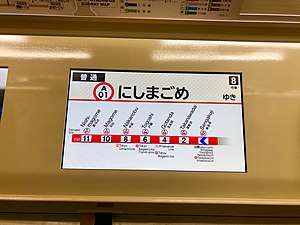Station Numbering


Station Numbering (Japanese: 駅ナンバリング; eki nanbaringu ) is a sign system used by some railway companies in Japan, which assigns station codes consisting of a couple of letters and numbers to train stations. It aims to facilitate navigation for foreigner travelers not familiar with the local language[1] by using globally spread characters (Latin letters and arabic numbers). The same system is also adopted by some railway companies in other countries/regions such as Mainland China, Taiwan, South Korea, Singapore and Thailand.
Structure
The station number is often composed of a symbol part and a number part. However, it may only have the numerical part in some cases where a rail company operates only one route or the route is completely insolated (hasn't transfer stations).
Symbol part
Line symbols usually consist of one or two letters which are often abbreviations of the Romaji notation of the line name, many of them being the initials. However, when there are more than two lines with the same initials in the same region, either of them is often changed in order to avoid duplicated line symbols, even across different company lines. (e.g. Marunouchi line uses ‘M’ M and Mita line uses ‘I’ I) Another method to avoid duplicated symbols is to assign them in alphabetical order (A to Z) in the first place instead of using abbreviations.[2]
In Mainland China and South Korea, the use of numbers is more common since most lines are named with numbers (e.g. Line 1). In that case, the station number for the first station of line 2 would be "201".
Number part
The number part is usually a series of numbers starting with 00 or 01 and is often written in two digits.
If there is a branch line branching off from the main line (like a ‘Y’ shape track), skipped numbers[3] or branch numbers such as "211-1"[4] are assigned.
If a new station is added between stations of, for example, number 08 and 09, branch numbers such as "08-1" are assigned in order not to change the existing station numbers, especially in western Japan. The same method is used by city buses and highway interchanges in Japan. As an exception, JR West takes the approach to assign decimal numbers like "08.5".[5] Meanwhile, there are cases where the station numbers are shifted and renumbered.
Companies using Station Numbering
Japan
- Hokkaidō region
- Tōhoku region
- Kantō region
- East Japan Railway Company - adopted in 2016/8/20[6]
- Tokyo Monorail
- Tokyo Waterfront Area Rapid Transit (Rinkai Line)
- Tokyo Metro
- Tokyo Metropolitan Bureau of Transportation (Toei Subway)
- Tokyo Waterfront New Transit (Yurikamome)
- Keisei Electric Railway
- Keikyu
- Tokyu Corporation
- Tobu Railway
- Seibu Railway
- Keio Corporation
- Odakyu Electric Railway
- Sagami Railway (Sotetsu)
- Metropolitan Intercity Railway Company (Tsukuba Express)
- Yokohama Municipal Subway
- Kanazawa Seaside Line
- Enoshima Electric Railway
- Shonan Monorail
- Tōyō Rapid Railway (Tōyō Rapid Railway Line)
- Saitama Railway Corporation (Saitama Rapid Railway Line)
- Watarase Keikoku Railway (Watarase Keikoku Line)
- Tokyo Tama Intercity Monorail (Tama Toshi Monorail)
- Saitama New Urban Transit (New Shuttle)
- Ryutetsu (Nagareyama Line)
- East Japan Railway Company - adopted in 2016/8/20[6]
- Chūbu region
- Central Japan Railway Company - adopted in 2018/3[7]
- Nagoya Municipal Subway
- Linimo
- Aichi Loop Line
- Meitetsu
- Izukyū Corporation
- Izuhakone Railway
- Fuji Kyuko
- Nagano Electric Railway
- Ueda Electric Railway
- Alpico Kōtsū
- Echizen Railway
- Nagaragawa Railway
- Akechi Railway
- Shizuoka Railway
- Enshu Railway
- Toyohashi Railroad
- Kansai (Kinki and Chūgoku) region
- West Japan Railway Company
- Osaka Metro
- Ise Railway
- Nankai Electric Railway
- Semboku Rapid Railway
- Hankai Tramway
- Kyoto Municipal Subway
- Kitakinki Tango Railway
- Osaka Monorail
- Kintetsu Railway
- Kobe Municipal Subway
- Hokushin Kyūkō Electric Railway
- Kobe New Transit
- Hankyu
- Nose Electric Railway
- Hanshin Electric Railway
- Sanyo Electric Railway
- Kobe Electric Railway
- Keihan Electric Railway
- Keifuku Electric Railroad
- Eizan Electric Railway
- Wakayama Electric Railway
- Hiroshima Electric Railway
- Ichibata Electric Railway
- Shikoku region
- Kyūshū region
South Korea
- Korail
- Seoul Metropolitan Subway
- Seoul Metro
- Incheon Subway
- Seoul Metro Line 9 Corporation
- Airport Railroad Corporation (AREX)
- UiTrans LRT Co. (Ui LRT)
- Yongin Rapid Transit Corporation (Everline)
- Uijeongbu LRT Corporation (U Line)
- NeoTrans Co. Ltd. (Shinbundang Line)
- E-Rail (Seohae Line)
- Busan Metro
- Busan–Gimhae Light Rail Transit Operation Corporation
- Daegu Metro
- Daejeon Metro
- Gwangju Metro
Mainland China
Taiwan
Singapore
Thai
See also
References
- ↑ "JR East to introduce numbering system at all stations in Tokyo". Japan Today. 2016-04-08. Retrieved 2018-08-18.
- ↑ JR West and JR Central uses this method.
- ↑ Keikyū Main Line and other lines use skipped numbers.
- ↑ Nankai Electric Railway and others use branch numbers.
- ↑ "「駅ナンバー」入力できっぷ購入も JR西が導入へ". 朝日新聞. Archived from the original on 2016-07-20. Retrieved 2017-11-01.
- ↑ "首都圏エリアへ「駅ナンバリング」を導入します" (PDF). 東日本旅客鉄道株式会社. 2016-04-02. Retrieved 2018-08-18.
- ↑ "【社長会見】在来線駅に駅ナンバリングを導入します" (PDF). 東海旅客鉄道株式会社. 2017-12-13. Retrieved 2018-08-18.
External links